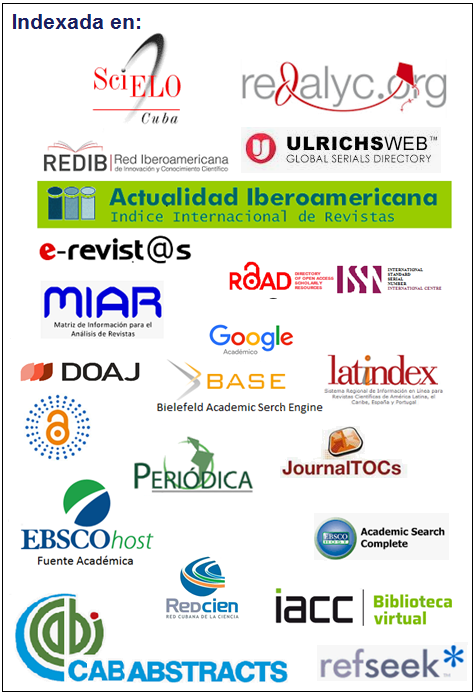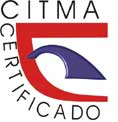Scenarios Susceptible to Induced Liquefaction Caused by High Magnitude Earthquakes in Santiago de Cuba
Keywords:
soil liquefaction, geological engineering, urban planning, Santiago de Cuba.Abstract
The objective of this investigation was to define the zoning of soil liquefaction potential for the Guillermón Moncada Popular Council in the municipality of Santiago de Cuba. The engineering and geological conditions and seismic peculiarities favoring a seism to take place were assessed. The safety factor was re-calculated after determining possible maximum intensity values based on seismic magnitudes that can trigger the soil of the investigated area to liquefy. A scheme of the area´s soil susceptibility to liquefaction was obtained. Based on this result, it was concluded that the sectors that are most likely to experience soil liquefaction if an earthquake of magnitudes ranging between 7,75 and 8 occurs are located towards the center-east of the Popular Council with sandy-clayey soils being predominant. This information is very useful for the location and planning of engineering construction works in the area.Downloads
References
ALCOCER, S. M.; MELI, R.; SÁNCHEZ, T. & FLORES, L. 1994: Comportamiento ante cargas laterales de sistemas de muros de mampostería confinada con diferentes grados de acoplamiento a flexión. Cuaderno de investigación (17): 53-76.
ÁLVAREZ, L.; CHUY, T. & COTILLA, M. 1991: Peligrosidad sísmica de Cuba. Una aproximación a la regionalización sísmica del territorio nacional. Revista Geofísica 35: 125-150.
CHUY, T. 2010: Modelo del peligro sísmico de la provincia de Santiago de Cuba. Archivos CENAIS.
GONZÁLEZ, B. & PÉREZ, L. D. 2000: Escenarios de peligro sísmico y de fenómenos geotécnicos. En: 2do Taller de Prevención de Desastres. UNAICC, La Habana, p. 1-14.
GONZÁLEZ-LABBÉ, C. 2011: Comparación entre la metodología para evaluar el potencial de riesgo de licuefacción y los catastros realizados luego del terremoto de 2010 en concepción. Tesis de diploma. Universidad del Bio Bio. Argentina.
GUASCH, F. & OLIVA, R. A. 2014: Análisis de la vulnerabilidad habitacional y los riesgos inducidos en los edificios altos de la ciudad de Santiago de Cuba. Archivos CENAIS.
HENRÍQUEZ-PANTALEÓN, C. 2007: Mejora de terrenos potencialmente licuables con inyecciones de compactación. Carlos Otero Mazo y Gustavo Armijo Palacio (Tutores). Tesis doctoral. Universidad Politécnica de Madrid. 691 p.
HERRERA, I. 2015: Delimitación de escenarios susceptibles a la licuefacción inducido por terremotos de gran magnitud en el Consejo Popular Guillermón Moncada del municipio de Santiago de Cuba. Trabajo de diploma. Instituto Superior Minero Metalúrgico. 83 p.
LIAO, S. & WHITMAN, R. V. 1986: Overburden Correction Factors for SPT in Sand. Journal of geotechnical engineering 112(3): 373-377.
ORDAZ-HERNÁNDEZ, A.; HERNÁNDEZ-SANTANA, J. R.; CHUY, T. J. & GARCÍA, J. A. 2013: La susceptibilidad a la licuefacción en el emplazamiento de la ciudad de San Cristóbal, Cuba Occidental. Minería y Geología 29(2): 1-15.
PERUCCA, L.; PÉREZ, A. & NAVARRO, C. 2006: Fenómenos de licuefacción asociados a terremotos históricos. Su análisis en la evaluación del peligro sísmico en la Argentina. Revista de la Asociación Geológica Argentina 61(4): 567-578.
ROBERTSON, P. K. & WRIDE, C. E. 1998: Evaluating cyclic liquefaction potential using the cone penetration test. Canadian Geotechnical Journal 35(3): 442-459.
SEED, H. B. & IDRISS, I. M. 1971: A Simplified procedure for evaluating soil liquefaction potential. Journal of soil Mechanics and Foundation Engineering Division 97(9): 1 249- 1 273.
SEED, H. B. & IDRISS, I. M. 1982: Ground motions and soil liquefaction during earthquakes. Technical report (Vol. 5). Earthquake Engineering Research Institute.
SEED, H. B. & LEE, K. L. 1966: Liquefaction on saturated sands during cyclic loading. Journal of the Soil Mechanics and Foundations Division 92(6): 105-134.
SEED, H. B.; IDRISS, I. M. & ARANGO, I. 1983: Evaluation of Liquefaction Potential Using Field Performance Data. Journal of Geotechnical Engineering 109(3): 481-485.
TOKIMATSU, K. & YOSHIMI, Y. 1983: Empirical Correlation of Soil Liquefaction Based on SPT N-value and Fines Content. Soils and Foundations 23(4): 56-74.
VALLEJO, L. 2002: Ingeniería Geológica. Pearson Educación, Madrid, 744 p.
VÁZQUEZ, J. C. 2005: Utilización de parámetros ingeniero-geológicos en la precisión de la licuación. Caso Santiago de Cuba. En: 1ra Convención de las Geociencias y la Química aplicadas a la construcción, p. 1-8.
YOUD, T. L.; IDRISS, I. M.; ANDRUS, R. D.; ARANGO, I.; CASTRO, G.; CHRISTIAN, J. T., ... & ISHIHARA, K. 2001: Liquefaction resistance of soils: Summary Report from the 1996 and 1998 NCEER/NSF Workshops on evaluation of liquefaction resistance of soils. Journal of geotechnical and geoenvironmental engineering 127(10): 817-833.
ZAPATA, J. A. 1996: Utilización de variantes metodológicas de microzonación sísmica en la ciudad de Santiago de Cuba. Tesis doctoral. CENAIS, Santiago de Cuba, 111 p.
Published
How to Cite
Issue
Section
- Authors retain copyright and guaranteeing the right magazine to be the first publication of the work as licensed under a Creative Commons Attribution-NonCommercial that allows others to share the work with an acknowledgment of the work's authorship and initial publication in this journal.
- Authors may establish separate supplemental agreements for the exclusive distribution version of the work published in the journal (eg, place it in an institutional repository or publish it in a book), with an acknowledgment of its initial publication in this journal.
- Authors are allowed and recommended to disseminate their work through the Internet (e.g., in institutional telematic archives or on their websites) before and during the submission process, which can produce interesting exchanges and increase citations of the published work. (See The effect of open access)




